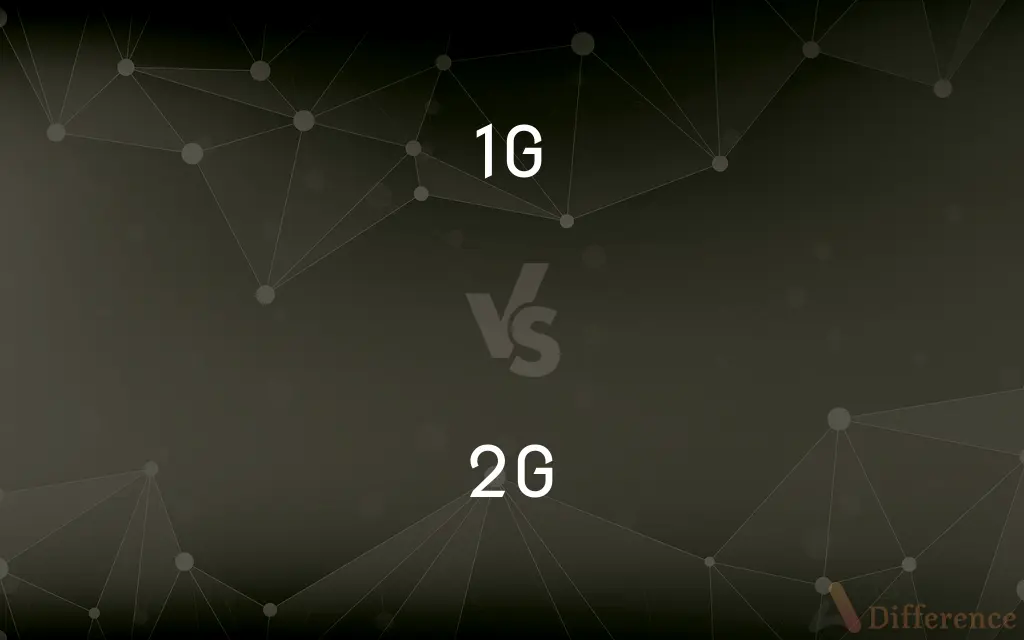1G vs. 2G — What's the Difference?
By Maham Liaqat & Urooj Arif — Published on April 15, 2024
1G represents the first generation of mobile networks, offering analog voice communication, while 2G introduced digital technology, enabling SMS, MMS, and basic internet services, marking a significant advancement in mobile telecommunications.

Difference Between 1G and 2G
Table of Contents
ADVERTISEMENT
Key Differences
1G, or the first generation of mobile telecommunications, introduced the world to mobile voice communication through analog signals. This technology allowed users to make voice calls wirelessly, a revolutionary step forward at the time. However, 1G networks had limitations, including poor voice quality, limited coverage, and a lack of security, as analog signals could be easily intercepted. On the other hand, 2G, or the second generation, brought a significant leap in technology by transitioning to digital signals. This shift not only improved voice call quality and security but also introduced new services like SMS (Short Message Service), MMS (Multimedia Messaging Service), and basic internet connectivity.
The transition from 1G to 2G marked the beginning of digital mobile networks, significantly enhancing the efficiency of frequency spectrum use. 2G networks, such as GSM (Global System for Mobile Communications), used digital encryption to secure communications, addressing the security vulnerabilities of 1G. Additionally, the introduction of data services in 2G networks laid the groundwork for mobile internet, albeit at slow speeds by today's standards.
While 1G networks were groundbreaking, offering mobility in communication, they were constrained by their analog nature, leading to high battery consumption and bulky devices. 2G networks, on the other hand, with their digital technology, allowed for smaller, more energy-efficient devices and improved coverage, making mobile phones more accessible to the general public.
2G technologies also introduced the concept of SMS, revolutionizing the way people communicate by allowing text messages to be sent and received alongside voice communication. This feature became one of the defining elements of mobile communication and set the stage for the development of more advanced data services.
The evolution from 1G to 2G was a pivotal moment in mobile telecommunications, moving from analog to digital, enhancing security, and introducing data services that would become the foundation for future generations of mobile technology.
ADVERTISEMENT
Comparison Chart
Technology
Analog
Digital
Communication Type
Voice only
Voice, SMS, MMS, basic internet
Security
Low (easily intercepted)
High (digital encryption)
Efficiency
Lower spectrum efficiency
Higher spectrum efficiency
Devices
Bulky with high battery consumption
Smaller, more energy-efficient
Compare with Definitions
1G
Provided basic mobile voice communication.
Making a call on a 1G network was a novelty in the early 1980s.
2G
Enabled encrypted communications, improving security.
Thanks to 2G, mobile communications became more secure with digital encryption.
1G
Characterized by poor security and call quality.
1G calls often had static and were prone to eavesdropping.
2G
Allowed for smaller, more efficient mobile devices.
2G phones were more compact and had longer battery life than their 1G predecessors.
1G
Limited to voice communication without support for text or data.
With 1G, there was no way to send text messages or access the internet.
2G
The second generation of mobile networks, introducing digital technology.
2G networks brought significant improvements like SMS and basic internet.
1G
The first generation of mobile telecommunications, using analog technology.
1G networks revolutionized communication by introducing mobile voice calls.
2G
Laid the foundation for the mobile internet.
2G was the first step towards accessing the internet on mobile devices.
1G
Marked the beginning of mobile telephony.
1G laid the groundwork for future developments in mobile technology.
2G
Introduced data services such as SMS and MMS.
Sending a text message became possible with the advent of 2G technology.
Common Curiosities
How did 2G improve upon 1G?
2G introduced digital encryption for secure communications, more efficient use of the spectrum, and data services like SMS and internet access, improving call quality and device efficiency.
What is 1G?
1G is the first generation of mobile telecommunications, primarily supporting analog voice calls.
Are 1G networks still in use?
No, 1G networks have been largely phased out in favor of more advanced digital mobile technologies.
Is SMS a 2G technology?
Yes, SMS was introduced with 2G technology, revolutionizing how people communicate by enabling the exchange of text messages.
What is 2G?
2G is the second generation of mobile telecommunications, introducing digital technology for voice calls, SMS, MMS, and basic internet services.
What impact did 2G have on mobile communication?
2G greatly expanded the capabilities of mobile devices beyond voice calls, introducing text messaging and basic data services, thereby shaping the future direction of mobile telecommunications.
Can 2G devices access the internet?
Yes, 2G devices can access the internet, but at very slow speeds, suitable only for basic tasks like sending emails or simple web browsing.
What made 2G more secure than 1G?
2G's use of digital encryption significantly enhanced the security of communications, making it much harder to intercept and decipher calls and messages.
Did 2G phones have better battery life than 1G phones?
Yes, due to the more efficient digital technology, 2G phones generally had better battery life and were more compact than 1G phones.
How did the transition from 1G to 2G affect mobile phone design?
The shift to 2G allowed for smaller, more energy-efficient mobile phones, making them more accessible and convenient for everyday use.
Share Your Discovery

Previous Comparison
Kosher Salt vs. Sea Salt
Next Comparison
Violin vs. ViolasAuthor Spotlight
Written by
Maham LiaqatCo-written by
Urooj ArifUrooj is a skilled content writer at Ask Difference, known for her exceptional ability to simplify complex topics into engaging and informative content. With a passion for research and a flair for clear, concise writing, she consistently delivers articles that resonate with our diverse audience.













































